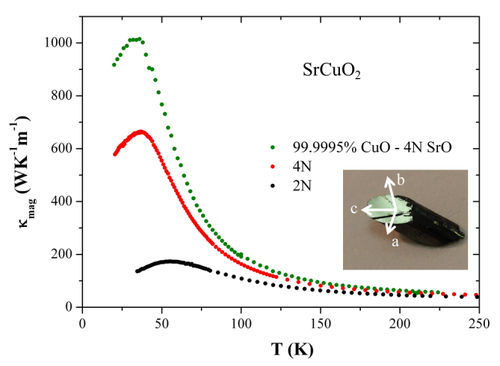Anisotropic thermal conductivity in low dimensional cuprates
contacts: Loreynne Pinsard-Gaudart, Romuald Saint-Martin
Today’s new technologies bring increasing demands to the electronics industry whose capacity of electronic circuits and related microprocessors increases very rapidly, following Moore’s law. The increasing number of transistors per unit area brings about significant heating which may be harmful to the good functioning of the systems and creates problems in the evacuation of the very localized heat generated in the electronic components. In order to control the heat flow which is produced, it is essential to use new materials able to conduct rapidly and efficiently, i. e. unidirectionally, the heat toward a heat sink.
For the past six years, our team pursued the work in the field of low-dimensional Quantum Magnets which exhibit the particularly interesting property of one-dimensional heat transport (collaboration with IFW, Dresden). Heat transfer processes in the solid state have always proved to be of fundamental and applied importance. An insight into the behavior and interaction of quasiparticles, ground states, and associated excitations in the non-equilibrium state can be obtained from transport phenomena. Conventionally, electrons and phonons were known to be the carriers of heat in solids. However, substantial experimental evidence gave support to the idea that heat transport can be achieved via excitations of the spin system. The investigated materials are the low dimensional cuprates Sr2CuO3 (213), SrCuO2 (112) and La5Ca9Cu24O41 (LCCO) exhibiting in their structures an alignment of Cu2+ ions of spin ½ as linear chains or ladders, showing thus a distinct 1D character. Single crystals are therefore required. In order to realize thermal conductivity measurements (IFW) in the best conditions, perfect homogeneous single crystals of excellent quality were synthesized by the Travelling Solvent Zone Method.
Their thermal conductivity in the 1D direction is described as the sum of two contributions, one phononic and the other of magnetic origin. In order to obtain a better understanding of the different competitive interaction mechanisms, the influence on thermal conductivity of the purity of the compounds and also of doping on the copper site (and strontium site) has been already investigated, see figure.
 Figure : Magnetic thermal conductivity κmag of SrCuO2 single crystal for different purities. This extreme sensibility to impurities implies that spinon-defect scattering is the most relevant process at low-T. Inset: Single crystal of SrCuO2 with 4N (99.99%) purity.
Figure : Magnetic thermal conductivity κmag of SrCuO2 single crystal for different purities. This extreme sensibility to impurities implies that spinon-defect scattering is the most relevant process at low-T. Inset: Single crystal of SrCuO2 with 4N (99.99%) purity.
selected publications:
- "Single-crystal growth of Mg- and Ni-doped chain compound SrCuO2 by the traveling-solvent Floating-zone method and chain breaking effect induced by the dopants", R. Saint-Martin, P. Berthet, A. Revcolevschi, Journal of Crystal Growth 415, 118 (2015)
- "Spin Gap in the Single Spin-1/2 Chain Cuprate Sr1.9Ca0.1CuO3", F. Hammerath, E. M. Brüning, S. Sanna, A. Mohan, Y. Utz, N. S. Beesetty, R. Saint-Martin, A. Revcolevschi, C. Hess, B. Büchner, and H.-J. Grafe, Physical Review B 89, 188410 (2014)
- "Bond disorder and spinon heat transport in the S = ½ Heisenberg spin chain compound Sr2CuO3: from clean to dirty limits", A.Mohan, N. Sekhar Beesetty, N. Hlubek, R. Saint-Martin, A. Revcolevschi, B. Büchner, C. Hess, Physical Review B 89, 104302 (2014)
- "Phonon-Magnon Interaction in Low Dimensional Quantum Magnets Observed by Dynamic Heat Transport Measurements", M. Montagnese, M. Otter, X. Zotos, D. A. Fishman, N. Hlubek, O. Mityashkin, C. Hess, R. Saint-Martin, S. Singh, A. Revcolevschi, and P. H. M. van Loosdrecht, Physical Review Letters 110, 147206 (2013)
- "Bond disorder and breakdown of ballistic heat transport in the spin-1/2 antiferromagnetic Heisenberg chain as seen in Ca-doped SrCuO2", N. Hlubek, P. Ribeiro, R. Saint-Martin, S. Nishimoto, A. Revcolevschi, S.-L. Drechsler, G. Behr, J. Trinckau, J. E. Hamann-Borrero, J. Geck, B. Büchner, and C. Hess, Physical Review B 84, 214419 (2011)

